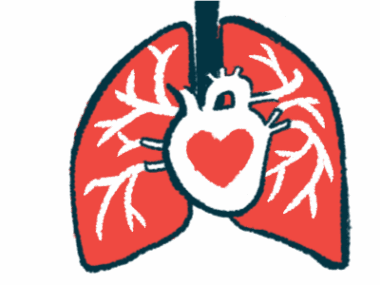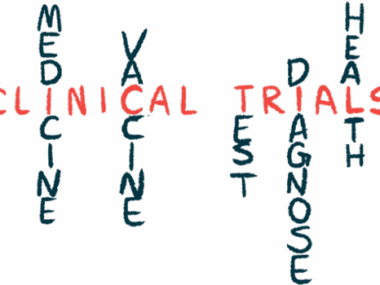Heart involvement seen for 1 in 10 pulmonary sarcoidosis patients
Imaging scans confirmed cardiac sarcoidosis at diagnosis for over 9% in study
Written by |

Nearly 1 in 10 people with pulmonary sarcoidosis also have heart involvement, or cardiac sarcoidosis, at the time of their initial diagnosis with the rare inflammatory disease occurring in the lungs, according to a study in Japan.
Further, another 3.8% of patients subsequently develop cardiac sarcoidosis, the data showed. Abnormalities in a heart echocardiogram — a noninvasive test to assess heart structure and function — were the most common initial findings prompting a cardiac sarcoidosis diagnosis, per the study.
“At the time of diagnosis of pulmonary sarcoidosis, cardiac complications occurred in approximately 10% of the patients,” the researchers wrote, noting that, “when addressing sarcoidosis, the pattern of organ involvement is important for early diagnosis and management.”
The team also noted that “further research on the varied disease activity of different organs in sarcoidosis is needed.”
The study, “Prevalence, incidence, and clinical features of cardiac involvement in patients with pulmonary sarcoidosis,” was published in the journal Respiratory Medicine.
Investigating risk factors for, prevalence of cardiac sarcoidosis
Sarcoidosis is caused by chronic inflammation that results in the formation of clumps of abnormally activated immune cells, called granulomas, in several organs. Over time, granulomas can become calcified, or bone-like, and cause permanent damage.
Most commonly, these clumps accumulate in the lungs, but other organs, including the heart, may also be affected. When there is heart involvement, early diagnosis and treatment are advised to avoid serious complications like heart failure.
“However, limited data are available on the prevalence, incidence, and risk factors for [cardiac sarcoidosis] in patients with [pulmonary sarcoidosis],” the researchers wrote.
To learn more, researchers in Japan retrospectively evaluated data from 438 adults who were diagnosed with biopsy-confirmed pulmonary sarcoidosis between January 2003 and March 2021 at Hokkaido University Hospital in Sapporo.
These patients had a mean age of 56 and nearly two-thirds (64%) were women. Besides the lungs, the disease mostly affected the eyes (75.3%). At diagnosis, several additional assessments were done, including blood tests and a heart echocardiogram.
A total of 74 patients (16.9%) were suspected of also having heart involvement. These individuals underwent subsequent examinations using PET and MRI imaging scans that confirmed the presence of cardiac sarcoidosis in 40 of them — 9.1% of all the patients — at the time of pulmonary sarcoidosis diagnosis.
Those with cardiac sarcoidosis had significantly lower cell counts versus those without heart involvement in the bronchoalveolar lavage fluid, or BALF, a fluid sample collected from the lower respiratory tract.
This included a lower percentage of lymphocytes, a type of immune cells that include B- and T-cells, and a lower CD4-positive to CD8-positive T-cell ratio, which indicates immune system imbalance.
Those with heart involvement also had lower blood levels of the sarcoidosis marker angiotensin-converting enzyme, known as ACE (17.4 vs. 19.9 units/mL) and higher blood levels of brain natriuretic peptide (BNP), a marker of heart damage (23.5 vs. 12.3 picograms/mL).
These individuals were also less affected by eye complications (43% vs. 78%), but more affected by kidney involvement (13% vs. 3%).
Cardiac sarcoidosis later diagnosed for 4% of those with heart involvement
Of the 365 patients with at least six months of follow-up, 31 were suspected to have cardiac sarcoidosis. Among them, 14 — 3.8% of the suspected patients — received a diagnosis within a median of 62 months, or about five years.
This corresponded to an incidence of cardiac sarcoidosis at a rate of 0.0075 per person-year, meaning that for every 30 patients followed, one developed cardiac sarcoidosis about every four years.
Those who developed heart disease also had lower cell counts and CD4 to CD8 ratio in BALF, more organs affected by the disease (median of 2.8 vs. 2), and higher BNP levels.
“Low [blood ACE] concentration, lymphocyte level, and CD4/CD8 ratio in the BALF may be unique features of patients with [cardiac sarcoidosis] that pulmonologists should consider when monitoring patients with [pulmonary sarcoidosis],” the researchers wrote.
Although the prognosis is generally favorable, early diagnosis and treatment of cardiac involvement [in patients] are important as it may lead to heart failure and sudden death.
Electrocardiographic abnormalities, particularly problems with the heart’s rate and rhythm, were the most common initial findings of cardiac sarcoidosis, leading to such a diagnosis both at the time of pulmonary sarcoidosis (88%) and during follow-up (86%).
Also, at initial diagnosis, patients with cardiac sarcoidosis had a lower left ventricle ejection fraction, a measure of heart function, than those diagnosed with cardiac sarcoidosis during follow-up.
“Decreased LVEF is an established poor prognostic factor for [cardiac sarcoidosis],” the researchers noted. The results indicate “the need for careful follow-up of these patients due to the risk of cardiac events,” the team added.
According to the researchers, these findings highlight the need for clinicians to be on the lookout for signs of heart involvement when diagnosing pulmonary sarcoidosis patients.
“Although the prognosis is generally favorable, early diagnosis and treatment of cardiac involvement are important as it may lead to heart failure and sudden death,” the researchers wrote.







